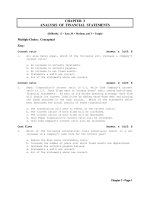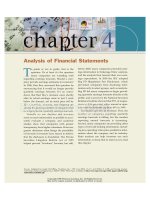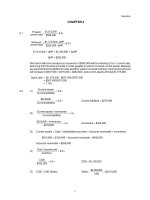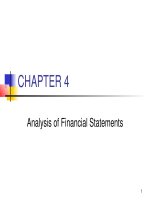The preparation and analysis of financial statements in DUYENHAI Trading and Manufacturer, Ltd
Bạn đang xem bản rút gọn của tài liệu. Xem và tải ngay bản đầy đủ của tài liệu tại đây (718.67 KB, 117 trang )
i
MINISTRY OF FINANCE
ACADEMY OF FINANCE
Student:
Lương Thanh Tùng
Class:
CQ54/21CL.02
Topic: “The preparation and analysis of financial statements in
DUYENHAI Trading and Manufacturer, Ltd”
GRADUATION THESIS
Major:
Business Accounting
Supervisor: MSc . Nguyễn Bá Linh
HÀ NỘI, Year 2020
Lương Thanh Tùng – CQ54/21CL.02
ii
LETTER OF DECLARATION
I hereby declare that this thesis the results of my own research and
has never been published in any work of others. During the process of making
this thesis, I have seriously taken research ethics; all findings of this project
are results of my own research and surveys; all references in this project are
clearly cited according to regulations.
I bear full responsibility to the fidelity of the number and data and
other contents of my work.
Hanoi,(day)… … (month)… … … (year) 20…..
Student
(Signature and Full name)
Lương Thanh Tùng – CQ54/21CL.02
iii
ACKNOWLEDGEMENT
Firstly, I am deeply indebted to my supervisor MSc. Nguyen Ba Linh
whose help, stimulating suggestions and encouragement helped me all the
time of research for and writing of this thesis.
I also want to thank Duyehai Trading and Manufacturer, Ltd for giving
me permission to commence this thesis in the first instance, to do the
necessary research work and to use departmental data.
I have furthermore to thank the Vice Director and Chief Accountant as
well as all seniors at Duyenhai Trading and Manufacturer, Ltd who gave and
confirmed this permission and encourage me to go ahead with my thesis.
Friends from Accounting Faculty also supported me in my thesis; I want
to thank them for all their support, interest and valuable conversations.
Especially, I would like to give my special thanks to my family whose
patient love enabled me to complete this work.
Finally, because of limitation of time and knowledge, mistakes are
unuavoidable, so I wish to have more opportunities. I also wish to receive
more contribution and suggestions to make my thesis better.
Lương Thanh Tùng – CQ54/21CL.02
iv
ABSTRACT
In the modern economic, Viet Nam business organizations face not only
opportunities but also great chanllenges. In order to catch up with the progress
and avoid being “eliminated”, all organizations are expected to always
perfecting and developing their managing system, especially on the aspect of
accounting, for having a good accounting system plays an important role in
making decisions and policies. If by any chance a certain item on the reports
(including balance sheet, cash flow statement, income statement) was
mispresented, any decisions based on that result may become unsuitable,
which will lead to failure. Therefore, my thesis with the topic “The
preparation and analysis of financial statements in Duyenhai Trading and
Manufacturer, Ltd” will point out the importance of financial statements,
components of financial statements and analysis of financial statements.
The main content is reflected in three chapters. The first chapter is about
the general theory of financial statements preparation and analysis in
enterprises. In chapter 2, by taking a scenario in Duyenhai Trading and
Manufacturer, Ltd, the thesis focuses on a real practice of preparing and
analyzing their financial statements. From that, chapter 3 points out some of
company’s strength and weaknesses and suggests some solutions to improve
the preparation and analysis of company’s financial statements.
In conclusion, the thesis has already been complete in comparison wiith
proposed objectives and targets in the introduction.
Lương Thanh Tùng – CQ54/21CL.02
v
LIST OF DIAGRAMS
No.
2.1
2.2
Content of diagram
Management mechanism in Duyenhai Trading and
Manufacturer Company, Ltd
Accounting system in Duyenhai Trading and Manufacturer
Company, Ltd
Pages
70
72
LIST OF TABLES
No.
Content of table
Pages
2.1
Main indicators reflects business results of the company
68
in 2019
2.2
Main indicators reflects financial position of the
69
company in 2019
2.3
Analysis of business results of the company in 2019
83
2.4
Overall assessment of company’s performance
85
2.5
Company’s financial structure
87
2.6
The asssets structure of the Company
89
2.7
Overview of company’s liquidity
91
2.8
Overall assessment of company’s debt ratio
93
Lương Thanh Tùng – CQ54/21CL.02
vi
TABLE OF CONTENT
PREFACE......................................................................................................................................01
CHAPTER 1......................................................................................................................................
GENERAL THEORY OF FINANCIAL STATEMENTS PREPARATION AND
ANALYSIS IN ENTERPRISES..................................................................................................04
1.1. General overview of financial statements and financial statements
analysis in enterprises.............................................................................................................04
1.1.1.The basics of financial statements.................................................................................04
1.1.1.1. Financial accounting information..............................................................................04
1.1.1.2. Definition and objectives of financial reporting........................................................06
1.1.1.3. Requirements of financial statements........................................................................07
1.1.2. Types of financial statements.......................................................................................08
1.1.2.1. Balance sheet.............................................................................................................08
1.1.2.2. Cash flow statement...................................................................................................13
1.1.2.3. Income statement.......................................................................................................17
1.1.2.4. Financial statement footnotes....................................................................................20
1.1.3. The basics of financial statement analysis....................................................................22
1.2. Financial statements preparation in enterprises...............................................................24
1.2.1. Statememt of financial position (balance sheet) preparation........................................24
1.2.1.1. Basis for preparation of the Balance Sheet................................................................24
1.2.1.2. Content and methods of setting up items in balance sheet of enterprises to meet the
assumption of continuous operation (Form B01-DN)............................................................25
1.2.2. Income statement preparation.......................................................................................26
1.2.2.1. Basis for preparation of income statement................................................................26
1.2.2.2. Contents and methods of preparation of item
in income statement (Form B02-DN)....................................................................................26
1.2.3. Cash flow statement preparation...................................................................................33
1.2.3.1. Basis for preparation of cash flow statement.............................................................33
Lương Thanh Tùng – CQ54/21CL.02
vii
1.2.3.2. Content and methods of preparation of items in
cash flow statement (Form B03-DN)......................................................................................34
1.2.4. Financial statement footnote preparation (BN 09-DN).................................................50
1.2.4.1. Basis for preparation of financial statement footnote................................................50
1.2.4.2. Content and methods of setting up items in financial statement footnote.................50
1.3. Financial statement analysis in enterprises......................................................................52
1.3.1.Documents and methodology for financial statements analysis....................................52
1.3.1.1. Documents for analysis..............................................................................................52
1.3.1.2. Methods of analysis...................................................................................................53
1.3.2. Content of financial statements analysis.......................................................................54
1.3.2.1. Business results's analysis..........................................................................................54
1.3.2.2. Balance sheet's key indicator analysis.......................................................................57
CONCLUSION OF CHAPTER 1..................................................................................................63
CHAPTER 2.................................................................................................................................
PRACTICAL SITUATION OF FINANCIAL STATEMENTS PREPARATION AND
ANALYSIS IN DUYENHAI TRADING AND MANUFACTURER, LTD.................................64
2.1.Overview of Duyenhai Trading and Manufacturer, Ltd...................................................64
2.1.1.Foundation and development of the company...............................................................64
2.1.1.1. General information about the company...................................................................64
2.1.1.2. Foundation and development.....................................................................................65
2.1.2. Characteristics of business operation............................................................................65
2.1.2.1. Main business sector..................................................................................................65
2.1.2.2. Advantages in company's operation..........................................................................67
2.1.2.3. Disadvantages in company's operation......................................................................67
2.1.2.4. Business results and financial position of the company in 2019...............................68
2.1.2.5. Production and business plan in 2020........................................................................69
2.1.3. Characteristics of organising management mechanism of Duyenhai Trading and
Manufacturer, Ltd...................................................................................................................70
2.1.4. Characteristics of organizing accounting system..........................................................72
Lương Thanh Tùng – CQ54/21CL.02
viii
2.1.4.1. Organization of accounting apparatus.......................................................................72
2.1.4.2. Accounting policies applied at the company.............................................................74
2.2. Practical situation of financial statement preparation and analysis at Duyenhai Trading
and Manufacturer, Ltd............................................................................................................74
2.2.1. Practical situation of financial statement preparation...................................................74
2.2.1.1. Accounts of general ledger at year end 2019.............................................................74
2.2.1.2. Statement of financial position at year end 2019.......................................................78
2.2.1.3. Income statement at year end 2019............................................................................80
2.2.1.4. Cash flow statement at year end 2019.......................................................................81
2.2.1.5. Financial statement footnote at year end 2019..........................................................82
2.2.2. Practical situation of financial statements analysis.......................................................83
2.2.2.1. Business results's analysis at Duyenhai Trading and Manufacturer..........................83
2.2.2.2. Balance sheet’s key indicator analysis.......................................................................85
2.3. Evaluattion of financial statement preparation and analysis at Duyenhai Trading and
Manufacturer, Ltd...................................................................................................................93
2.3.1. Achievements in financial statement preparation and analysis at
Duyenhai Trading and Manufacturer, Ltd..............................................................................94
2.3.2. Limitations in financial statement preparation and analysis at
Duyenhai Trading and Manufacturer, Ltd..............................................................................95
CONCLUSION OF CHAPTER 2..................................................................................................97
CHAPTER 3.......................................................................................................................................
SOME SOLUTIONS TO IMPROVE THE PREPARATION AND ANALYSIS OF FINANCIAL
STATEMENT AT DUYENHAI TRADING AND MANUFACTURER, LTD............................98
3.1. Development orientation of the company........................................................................98
3.1.1. Socio-economic scenario..............................................................................................98
3.1.2. Targets and business orienttation of the company........................................................98
3.2. Requirements for improving the preparation and analysis
of financial statements............................................................................................................99
Lương Thanh Tùng – CQ54/21CL.02
ix
3.3. Some solutions to improve the preparation and analysis
of financial statements..........................................................................................................102
CONCLUSION OF CHAPTER 3................................................................................................105
CONCLUSION.............................................................................................................................106
REFERENCES.............................................................................................................................108
Lương Thanh Tùng – CQ54/21CL.02
1
PREFACE
1. The urgency of the study
In the current situation, our country is in the process of economic
development and integration according to the development of the world and
the trend of the times. Economic integration and development is an
opportunity and also a great challenge for the country's economy in general
and in particular domestic enterprises in particular. This requires each
enterprise to make efforts, maximize its advantages, as well as overcome the
weaknesses that still exist in order to integrate with the world economy. In the
era where science and technology are advancing and upgrading by hour, a
single decision can decide the fate of an entire business entity.
To be able to make a right decision, the leaders must have information
about company’s current status presented clearly and faithfully, so that no
items shall be mistaken. Having a good accounting information system also
allows director to manage the company’s operation so that if any problem
arises, they can interfere and solve the problem in no time. But the accounting
information system is too complicated for users such as creditors, lendors, and
employees… to understand, so a need for a compact but fully and clearly –
presented occurred, and financial statements was made. Financial statements
are written records that convey the business activities and the financial
performance of a company.
Financial statements are often audited by government agencies,
accountants, firms, etc. to ensure accuracy and for tax, financing, or investing
purposes. Investors and financial analysts rely on financial data to analyze the
performance of a company and make predictions about its future direction of
Lương Thanh Tùng – CQ54/21CL.02
2
the company's stock price. Financial statements are the main source of
financial information for most decision makers.
On the base of practicing thesis and theories of preparing and analysing
financial statements which had been studied at the academy and
understanding practical situation at the company, under guidance and support
of supervisor, MSc Nguyen Ba Linh and the company’s employees, I had
achieved some success in researching company’s practical operation. This is
also an opportunity given to us by the academy to strenghthen the knowledge,
as well as develops suitable skills. Based on that, I decided to choose the topic
of “The preparation and analysis of financial statements in DUYENHAI
Trading and Manufacturer, Ltd” to make my graduation thesis.
2. The purpose of the study
Based on the theoretical basis that has been studied in combination with
the actual study in the enterprises, the topic of the thesis is selected and
studied to meet the following objectives:
− Obtain a brief view of process of preparing and analyzing financial
statements at Duyenhai Trading and Manufacturer, Ltd.
− Provide comments, evaluations to contribute to promoting the
development of the process of preparing and analyzing the financial
statements at the company.
3. The subject and scope of the study:
Subject: The preparation and analysis of financial statements at
Duyenhai Trading and Manufacturer, Ltd.
Lương Thanh Tùng – CQ54/21CL.02
3
Scope: The preparation and analysis of financial statements at
Duyenhai Trading and Manufacturer, Ltd in 2019
4. Research Method
− Direct observation method of implementing acconting principles
in preparing financial statements.
− Methods of survey, data collection and recording, during the
internship process, using direct interview, observation and research methods
to collect and record necessary documents related to the topic selected;
− Methods of synthesis and analysis: based on books, financial
statements and collected data synthesized as a bbasis for research and
practical analysis of practice untis.
5. The structure of thesis
The thesis includes three chapters
CHAPTER I: Genaral theory of financial statements preparation and
analysis in enterprises.
CHAPTER II: Practical situation of financial statements preparation
and analysis at Duyenhai Trading and Manufacturer, Ltd.
CHAPTER III: Some solutions to improve the preparation and
analysis of financial statements at Duyenhai Trading and Manufacturer,
Ltd.
Finally, I gave my humble appreciation to Msc, Mr Nguyen Ba Linh and
Mrs.Bui Thi Thi, chief accountant of Duyenhai Trading and Manufacturer,
Ltd for the guidance to help me accomplish this thesis.
Sincerely thanks!
Lương Thanh Tùng – CQ54/21CL.02
4
CHAPTER I
GENERAL THEORY OF FINANCIAL STATEMENTS PREPARATION
AND ANALYSIS IN ENTERPRISES
1.1. General overview of financial statements and financial statements
analysis in enterprises
1.1.1. The basics of financial statements
1.1.1.1. Financial accounting information
Accounting is the process of identifying, measuring, and communicating
economic information to permit informed judments and decisions by the users
of the information, as defined by The American Accounting Association. This
information is primalily financial−stated in money terms. Accounting, then, is
a measuring and communicating tool used to reflect on the activities of
profit−seeking business organizations and not−for−profit organizations. As
measurement and communication process for business, accounting supplies
information that permits informed judments and decisions by users of the
data.
Accounting information is the information that arises from business
transactions. Once identified, the information is then classified and recorded,
and it eventually finds its way into various reports.
The process of providing information
1) Identify stakeholders (users of accounting information): usually, the
users of accounting information are divided into two factions:
Internal users: includes owners, managers, employees
External users: includes customers, creditors, government
2) Assess stakeholders’s informational needs: each kind of user has a
different motives and objectives, therefore holds different needs of accounting
information.
Lương Thanh Tùng – CQ54/21CL.02
5
Owners: need to assess how well their business is performing.
They are also interested in knowing how risky their business is and can be.
Managers: need accounting information to plan, monitor and
make business decisions.
Employees: need accounting information to get a better
understanding of the company’s business, so that they may have proper plans
for future development.
Investors: need accounting information to know how well their
investment is performing, therefore decide should they keep investing or stop.
Lendors: need accounting information to assess their credit
worthiness, their ability to pay back loan.
Suppliers: need accounting information to assess the credit-
worthiness of its customers before offering goods and services on credit.
Tax Authorities: need accounting information of suppliers and
consumers in order to identify potential tax evaders. Occasionally, tax
authorities conduct audits of the tax returns filed by businesses in order to
verify the information with the underlying accounting records.
3) Design the accounting information system to meet stakeholders’s
needs.
An accounting information system (AIS) is a structure that a business
uses to collect, store, manage, process, retrieve and report its financial data
so it can be used by accountants, consultants, business analysts, managers,
chief financial officers (CFOs), auditors, regulators, and tax agencies.
4) Record economic data about business activities and events.
5) Prepare accounting report for stakeholders.
Lương Thanh Tùng – CQ54/21CL.02
6
1.1.1.2. Definition and objectives of financial reporting
a) Definition
Financial reporting is the financial results of an organization that are
released to its stakeholders and the public. This reporting is a key function of
the controller, who may be assisted by the investor relations officer if an
organization is publicly held. Financial reporting typically encompasses the
following documents and postings:
Financial statements, which include the income statement,
balance sheet, and statement of cash flows
Accompanying footnote disclosures, which include more detail on
certain topics, as prescribed by the relevant accounting
framework
Any financial information that the company chooses to post about
itself on its website
Annual reports issued to shareholders
Any prospectus issued to potential investors concerning the
issuance of securities by the organization
Financial statements are written records that convey the business
activities and the financial performance of a company. Financial statements
are often audited by government agencies, accountants, firms, etc. to ensure
accuracy and for tax, financing, or investing purposes.
b) Objectives
Financial reportings provide information about the reporting
entity that is useful to existing and potential investors, lendors and
other creditors in making decisions about providing resources to
the entity.
Lương Thanh Tùng – CQ54/21CL.02
7
The information provided about financial performance helps
existing and potential investors, lenders and other creditors to
understand the return the entity has produced on its economic
resources.
Decisions by invetors are about buying, selling or holding
euity and debt instruments depend on the returns that they expect
from an investment in those instruments, eg dividends, principal
and interest payments or market price increase.
Decisions by ledors are about providing or selling loans
and other forms of credit depend on the principal and interest
payments of other returns that they expect.
The information must reflect the effect on performance of
changes in market prices and/or interest rates.
1.1.1.3. Requirements of financial statements presentation
According to Article 101 of circular 200/2014/TT-BTC about
“Requirements for information presented in financial statements”, the
following are requirements for information presented in financial statements:
1. Information presented in the financial statements must be recorded
honestly and reasonably the financial situation, trading situation and income
of enterprises. To ensure honesty, the information must be complete,
objective, unmistaken.
- Information is only complete when including all the necessary
information to help users of financial statements to understand the nature,
forms and risks of transactions and events. For some items, the full
presentation must also describe more information about the quality, the
factors and circumstances that may affect the quality and nature of the items.
Lương Thanh Tùng – CQ54/21CL.02
8
- Objective presentation is unbiased selection or description on
financial information. Objective presentation must ensure neutrality which do
not focus, emphasis or reduce as well as perform other acts to alter the impact
of the financial information to become beneficial or unbeneficial for users of
financial statements.
- No errors mean no omissions in the description of the phenomenon
and no errors in the process of providing reporting information selected and
applied. No errors do not mean complete accuracy in all respects, for
example, estimating unobservable cost and value is difficult to determine to
be correct or incorrect. The presentation of an estimate is considered to be
honest, if the estimated value is described clearly, and the nature and
limitation of the estimating process is explained and there is no error in the
selection of appropriate figures in the estimate.
2. Financial information must be appropriate to help users of financial
statements to predict, analyze and make economic decisions.
3. Financial information must be presented fully in all important
respects. Information is considered to be important in case information is not
sufficient or inaccurate information may affect the decisions of users of
financial information of the reporting unit. Materiality shall be based on the
nature and magnitude, or both, of the relevant items presented in the financial
statements of a particular unit.
4. Information must be verifiable, timely and understandable.
5. Financial information must be presented consistently and must be
comparable among the accounting periods and enterprises.
1.1.2. Types of financial statements
1.1.2.1. Balance sheet
Lương Thanh Tùng – CQ54/21CL.02
9
* Definition of balance sheet
Balance sheet is a statement of the assets, liabilities, and capital of a
business or other organization at a particular point in time, detailing the
balance of income and expenditure over the preceding period.
* Nature and purpose of balance sheet
The purpose of the balance is to set out the financial position of a
business at a particular point in time.
It gives a snap shot of the assets, liabilities and equity position of
the entity at a particular point in time.
It sets out the assets of the entity on the one hand, and the claims
against it on the other.
* Format of balance sheet
There are two formats of presenting assets, liabilities and owners’
equity in the balance sheet – account format and report format. In account
format, the balance sheet is divided into left and right sides like a T account.
The assets are listed on the left hand side whereas both liabilities and owners’
equity are listed on the right hand side of the balance sheet. If all the elements
of the balance sheet are correctly listed, the total of asset side (i.e., left side)
must be equal to the total of liabilities and owners’ equity side (i.e., right
side).
Lương Thanh Tùng – CQ54/21CL.02
10
Picture 1: Example of account format
The report format (vertical format) is used more frequently. In vertical
format, the balance sheet elements are presented vertically i.e., assets section
is presented at the top and liabilities and owners equity sections are presented
below the assets section.
Lương Thanh Tùng – CQ54/21CL.02
11
BALANCE SHEET
As at 31 December 2019
Unit: VND
ASSETS
Codes
Notes
Closing balance
Opening balance
2,690,917,843
3,664,521,286
1,012,242,498
978,675,637
1,012,242,498
978,675,637
1,525,113,700
A - CURRENT ASSETS
100
I. Cash and cash equivalents
110
1. Cash
111
II. Short-term receivables
130
137,502,696
1. Short-term trade receivables
131
137,502,696
33,004,453
2. Short-term loan receivables
135
-
1,350,000,000
3. Other short-term receivables
136
III. Inventories
140
4
5
-
142,109,247
575,873,906
494,591,731
1. Inventories
141
575,873,906
494,591,731
IV. Other short-term assets
150
965,298,743
666,140,218
2. Value added tax deductibles
152
965,298,743
666,140,218
B. NON-CURRENT ASSETS
200
7,665,712,732
6,904,337,220
I. Fixed assets
220
7,385,419,635
6,258,944,559
1. Tangible fixed assets
221
7,385,419,635
6,258,944,559
222
16,449,101,428
14,572,436,428
- Accumulated depreciation
5. Held-to-maturity investments
II. Other long-term assets
223
255
260
(9,063,681,793)
280,293,097
(8,313,491,869)
645,392,661
1. Long-term prepayments
261
280,293,097
645,392,661
TOTAL ASSETS (270=100+200)
270
10,356,630,575
10,568,858,506
- Cost
6
Picture 2: Example of vertical format
Lương Thanh Tùng – CQ54/21CL.02









